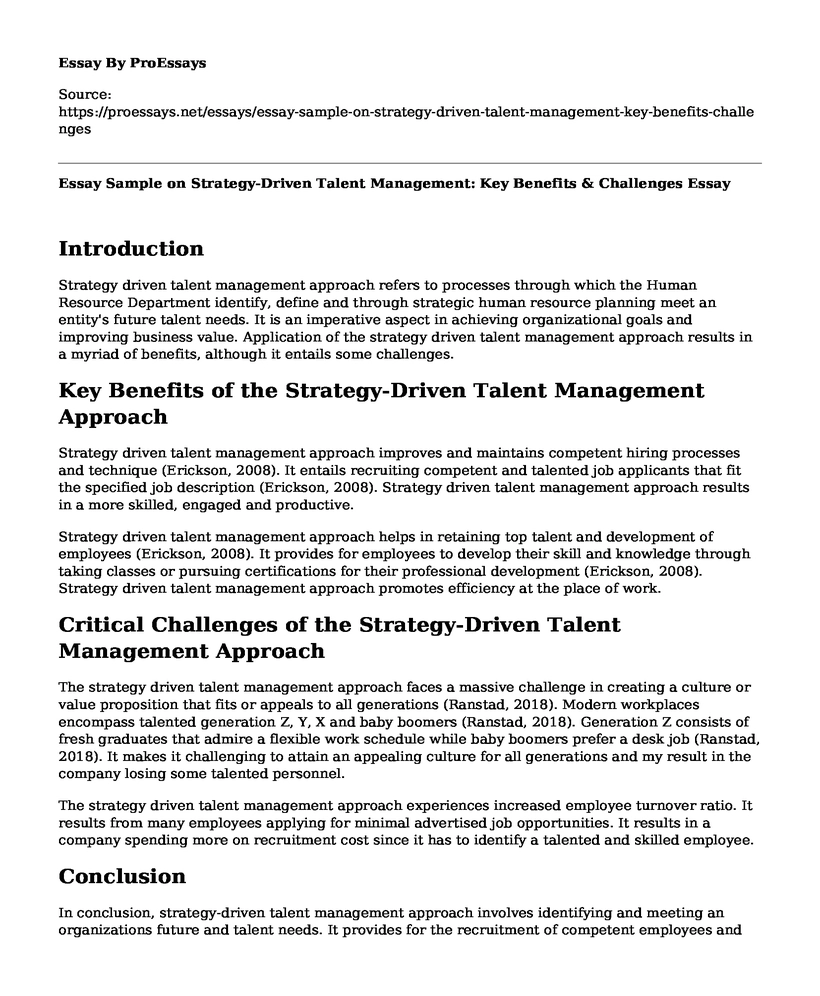Introduction
Strategy driven talent management approach refers to processes through which the Human Resource Department identify, define and through strategic human resource planning meet an entity's future talent needs. It is an imperative aspect in achieving organizational goals and improving business value. Application of the strategy driven talent management approach results in a myriad of benefits, although it entails some challenges.
Key Benefits of the Strategy-Driven Talent Management Approach
Strategy driven talent management approach improves and maintains competent hiring processes and technique (Erickson, 2008). It entails recruiting competent and talented job applicants that fit the specified job description (Erickson, 2008). Strategy driven talent management approach results in a more skilled, engaged and productive.
Strategy driven talent management approach helps in retaining top talent and development of employees (Erickson, 2008). It provides for employees to develop their skill and knowledge through taking classes or pursuing certifications for their professional development (Erickson, 2008). Strategy driven talent management approach promotes efficiency at the place of work.
Critical Challenges of the Strategy-Driven Talent Management Approach
The strategy driven talent management approach faces a massive challenge in creating a culture or value proposition that fits or appeals to all generations (Ranstad, 2018). Modern workplaces encompass talented generation Z, Y, X and baby boomers (Ranstad, 2018). Generation Z consists of fresh graduates that admire a flexible work schedule while baby boomers prefer a desk job (Ranstad, 2018). It makes it challenging to attain an appealing culture for all generations and my result in the company losing some talented personnel.
The strategy driven talent management approach experiences increased employee turnover ratio. It results from many employees applying for minimal advertised job opportunities. It results in a company spending more on recruitment cost since it has to identify a talented and skilled employee.
Conclusion
In conclusion, strategy-driven talent management approach involves identifying and meeting an organizations future and talent needs. It provides for the recruitment of competent employees and employee development. Strategy driven talent management approach entails challenges such as increased employee turnover ratio and difficulties in maintaining an appealing work culture across different generations.
References
Ranstad. (2018).The Five Biggest Talent Management Challenges in 2018.Retrieved 2020 February 25 from https://www.randstad.com/workforce-insights/talent-management/the-five-biggest-talent-management-challenges-in-2018/.
Erickson, T. (2008 June 20).Today's Top 10 Talent Management Challenges. Retrieved (2020 February 25) from https://hbr.org/2008/06/todays-top-10-talentmanagement.
Cite this page
Essay Sample on Strategy-Driven Talent Management: Key Benefits & Challenges. (2023, Apr 10). Retrieved from https://proessays.net/essays/essay-sample-on-strategy-driven-talent-management-key-benefits-challenges
If you are the original author of this essay and no longer wish to have it published on the ProEssays website, please click below to request its removal:
- Glencore Plc Organizational Operational Objectives - Essay Example
- Paper Example: Security Threats on Information Resource. Data Communication Systems
- Statements About Power and Knowledge Paper Example
- Essay Sample on Poor Team Performance: Causes and Solutions
- Essay on Making La Mela Leaner: Applying Lean Principles to an Italian Restaurant
- Essay Example on BSN Sports: Corporate Strategies for Distribution & Marketing of Sports Equipment
- Essay Example on Corporate Social Responsibility: Enhancing Brand Value & Improving Society







